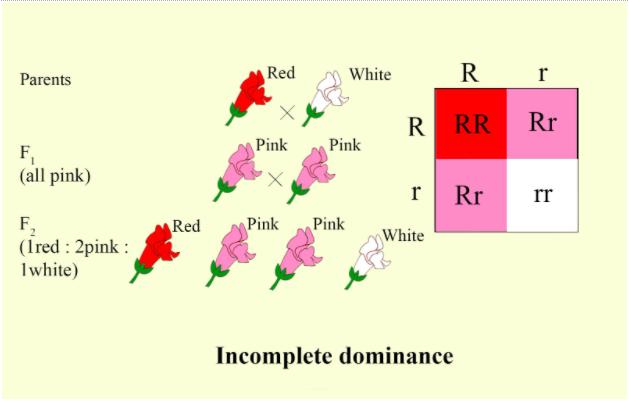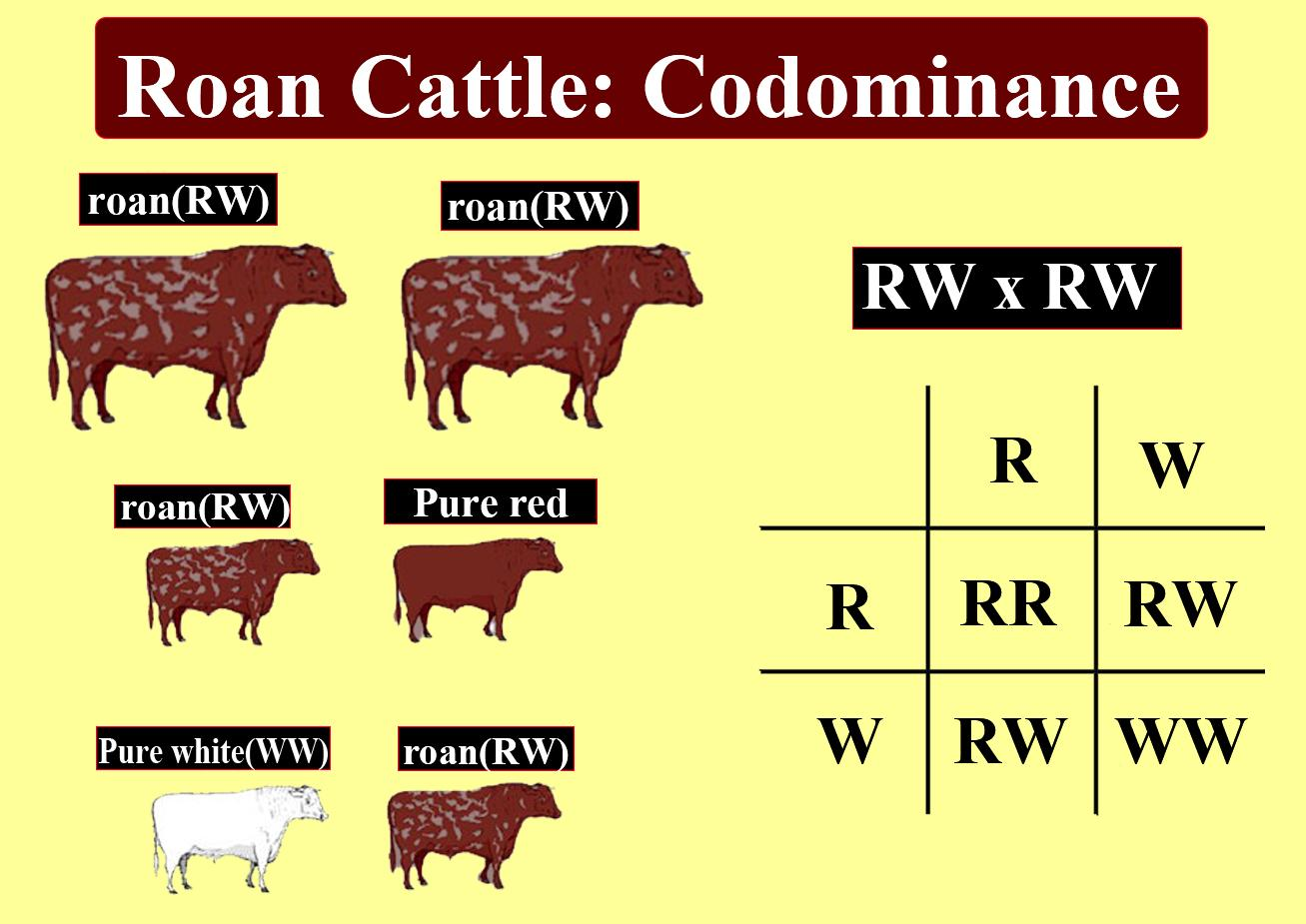What Are the Main Differences Between Incomplete Dominance and Codominance?
Incomplete dominance and codominance are two important patterns of inheritance in genetics. They explain how certain traits or characteristics appear in offspring when parents carry different versions (alleles) of a gene. Although both involve interactions between alleles, they differ in the way these alleles influence each other’s expression. Below, let us explore these concepts clearly and simply.
What is Incomplete Dominance?

Incomplete dominance occurs when a dominant allele does not completely mask the effect of a recessive allele. As a result, the offspring shows a blend of the two parental traits. This is different from complete dominance, where one allele completely overshadows the other.
Incomplete Dominance Example:
A classic example is the cross between red-flowered (RR) and white-flowered (rr) snapdragons (also known as Antirrhinum majus). The heterozygous offspring (Rr) produce pink flowers, illustrating a blend of red and white traits.
Key Points:
Offspring display an intermediate phenotype (mixed appearance).
A new phenotype emerges in the hybrid generation.
It is different from complete dominance, where the dominant trait alone is visible in the heterozygous offspring.
What is Codominance?

In codominance, both alleles in a heterozygous genotype express themselves equally and separately. Neither allele can mask the other, so both traits are visible in the offspring without blending.
Example: The blood Group ABO system in humans is the most well-known example. The A allele and the B allele are both dominant when compared to the O allele, but they are codominant relative to each other. Hence, a person inheriting one A allele and one B allele (genotype AB) will have a blood group that shows both A and B antigens on their red blood cells.
Key Points:
Both parental traits are clearly expressed without blending.
No new phenotype is formed, but rather, a combined effect of both alleles is observed.
Incomplete Dominance vs Codominance: Main Differences
Notice that in incomplete dominance vs codominance, the presence of an intermediate phenotype is a hallmark of incomplete dominance, whereas codominance allows each allele’s trait to be distinctly visible.
Difference Between Complete Dominance, Incomplete Dominance, and Codominance
Sometimes, it is helpful to compare all three inheritance patterns side by side:
Complete Dominance:
The dominant allele completely covers up the recessive allele.
The recessive trait remains unseen in heterozygotes.
Example: In peas, the purple flower colour is completely dominant over white.
Incomplete Dominance:
The dominant allele partially masks the recessive allele.
The offspring blend traits of both parents (pink flowers in snapdragons).
Codominance:
No allele hides the other.
The offspring show both traits separately (AB blood group).
Short Quiz (With Answers)
Try this quick quiz to strengthen your understanding:
Which inheritance pattern involves the blending of parental traits?
A. Codominance
B. Incomplete Dominance
C. Multiple Alleles
Answer: B. Incomplete Dominance
In codominance, which of the following statements is correct?
A. Both alleles are recessive
B. One allele is partially dominant
C. Both alleles are equally expressed.
Answer: C. Both alleles are equally expressed
Which example is associated with codominance?
A. Pink snapdragon flowers
B. AB Blood Group
C. White and red four o’clock plants
Answer: B. AB Blood Group
In incomplete dominance, a cross between a pure tall plant and a pure dwarf plant would produce
A. All tall plants
B. All dwarf plants
C. Plants of medium height
Answer: C. Plants of medium height
Related Topics


FAQs on Incomplete Dominance vs Codominance: Explained for Students
1. What is the main difference between incomplete dominance and codominance?
The main difference lies in how the alleles are expressed in a heterozygous individual. In incomplete dominance, the phenotype is a blend or intermediate of the two parent alleles, like a red and white flower producing a pink flower. In codominance, both alleles are fully and separately expressed, such as in the AB blood type, where both A and B antigens are present on red blood cells.
2. What is a classic example of incomplete dominance in plants as per the NCERT syllabus?
A classic example of incomplete dominance is the flower colour in the Snapdragon (Antirrhinum sp.) or the Four o' clock plant (Mirabilis jalapa). When a homozygous red-flowered plant (RR) is crossed with a homozygous white-flowered plant (ww), the heterozygous offspring (Rw) have pink flowers—an intermediate phenotype, not red.
3. What is the most common example of codominance in humans?
The most common and clear example of codominance in humans is the ABO blood group system. The alleles for A-type blood (IA) and B-type blood (IB) are codominant. If a person inherits both alleles (genotype IAIB), their red blood cells will produce both A and B antigens. Neither allele masks the other; both are fully expressed.
4. Why is the ABO blood group also an example of multiple alleles, in addition to codominance?
The ABO blood group system demonstrates multiple alleles because more than two alleles exist in the population to control this single trait. The three alleles are IA, IB, and i. While an individual can only have two of these alleles, the existence of a third allele in the gene pool is what defines it as a case of multiple allelism, making it a more complex inheritance pattern than simple Mendelian traits.
5. How do the phenotypic ratios in the F2 generation differ between incomplete dominance and simple Mendelian dominance?
This highlights a key difference in outcomes:
In Mendelian dominance, the F2 phenotypic ratio is 3:1 (e.g., 3 tall: 1 dwarf). However, the genotypic ratio is 1:2:1 (TT:Tt:tt).
In incomplete dominance, the F2 phenotypic ratio is 1:2:1 (e.g., 1 red: 2 pink: 1 white). This is because the heterozygote has its own unique phenotype. Here, the phenotypic ratio matches the genotypic ratio (RR:Rw:ww).
6. If incomplete dominance results in a 'blended' look, does this mean the alleles themselves have blended?
No, the alleles themselves do not blend. This is a common misconception. The alleles (e.g., for red and white colour) remain distinct and segregate independently during gamete formation, as per Mendel's laws. The 'blended' phenotype (e.g., pink flower) is a result of the interaction of the gene products from the two alleles in the heterozygote. For example, the 'R' allele produces red pigment, while the 'w' allele produces no pigment, resulting in a diluted, pink appearance in the 'Rw' offspring.
7. In what way are both incomplete dominance and codominance considered exceptions to Mendel's Law of Dominance?
Mendel's Law of Dominance states that in a heterozygous pair, one allele (the dominant one) will completely conceal the presence of the other (the recessive one). Both incomplete dominance and codominance are exceptions because in both patterns, the heterozygous phenotype is distinguishable from the homozygous dominant phenotype. Neither pattern shows the complete dominance described by Mendel.
8. How is understanding the difference between these two inheritance patterns useful in a real-world application like animal breeding?
Understanding this difference is crucial for predictive breeding. For example:
To get a Palomino horse (golden coat), which shows incomplete dominance, breeders must cross a chestnut horse and a cremello horse. Crossing two Palominos won't consistently produce Palomino offspring.
To get roan cattle (a mix of red and white hairs), which show codominance, breeders cross a red bull and a white cow. This predictable outcome is a direct result of both colour alleles being expressed simultaneously.










